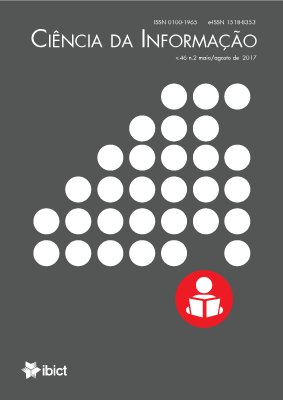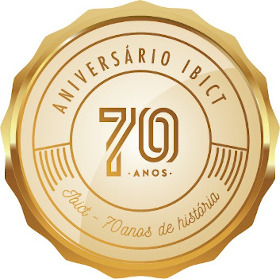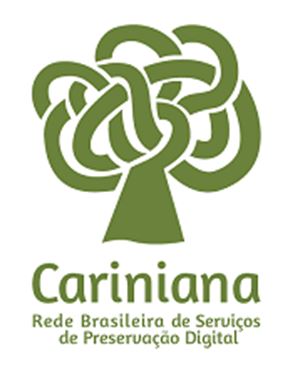El modelo de Bass en la literatura sobre Argopecten Purpuratus
DOI:
https://doi.org/10.18225/ci.inf.v46i2.4063Palavras-chave:
Modelo de Bass, Cienciometría, Ciencias marinas, Concha de abanico, Argopecten purpuratus,Resumo
El objetivo de este artículo es explorar el modelo Bass de difusión de innovaciones aplicándolo a la literatura producida desde 1956 hasta 2016, sobre Scallops, conocido científicamente como Argopecten purpuratus. Se identificaron 955 documentos producidos por 1.590 autores diferentes. Los autores que producen la literatura sobre Argopecten purpuratus tienen una preferencia para presentar sus contribuciones en forma de artículos publicados en revistas académicas, el 69% de las contribuciones tienen esta forma de publicación. El modelo de difusión de innovaciones de Bass estima para esta literatura que la influencia que los investigadores obtienen de la lectura de otros documentos sobre este mismo tema en los sistemas de información es inferior al 1% (coeficiente de innovación). El coeficiente de imitación q que mide la influencia que ejerce un grupo de adoptantes en las decisiones de adopción de otros posibles adoptantes es igual al 15.5%. El parámetro m que muestra el punto de saturación del campo, en este caso, el punto de saturación de los autores que publican sobre Argopecten purpuratus se alcanzaría cuando 2431 investigadores en el campo existen.
Downloads
Referências
BIBLIOGRAFIA
ARNTZ, W.E.; VALDIVIA, E. Incidencia del Fenómeno El Niño sobre los mariscos en el litoral peruano. Boletín del Instituto del Mar (Callao, Peru) v.11, p. 91-101, 1983.
AVILA, M.; PLAZA, U.; SCHNETTLER, P.; NILO, M.; PAVEZ, H.; TOLEDO, C. Estado de situación y perspectivas de la acuicultura en Chile. Chile, Instituto de Fomento Pesquero, 1998.
BANDIN, R.; MENDO, J. Asentamiento larval de la concha de abanico (Argopecten purpuratus) en colectores artificiales en la Bahía Independencia, Pisco, Perú. Investigaciones marinas, v. 27, p. 3-13, 1999.
BASS, F.M. A new product growth model for consumer durables. Management Science, v. 13, n. 5, p. 215-227, 1969.
BENITES, C. El desarrollo de la maricultura en el Perú con énfasis en la concha de abanico (Argopecten purpuratus) y langostinos (Pennaeus vannamei), pp. 196-201. In: H. SALZWEDEL Y LANDA (eds.). Recursos y dinámica del ecosistema de afloramiento peruano. Bol. Inst. Mar Perú-Callao, Vol. Extraordinario, 1988.
BENNION, BRUCE C.; NEUTON, LAURENCE A., "The epidemiology of research on 'Anomalous water'". Journal of the American Society forlnformation Science, 27(1), 53–56, Jan.–Feb. 1976.
BETTENCOURT, LUÍS M. A.; CINTRÓN-ARIAS, ARIEL; KAISER, DAVID I. ; CASTILLO-CHÁVEZ, CARLOS. The power of a good idea: quantitative modeling of the spread of ideas from epidemiological models, Physica A, v. 364, p. 513-536, 2006.
BOURDIEU, PIERRE. O campo científico. In: Bourdieu, Pierre. Sociologia. São Paulo: Ática, 1983. p. 122-155.
BRAND, ANDREW R. Scallop Ecology: Distribution and Behaviour. In: Scallops: Biology Ecology and Aquaculture: Developments in Aquaculture and Fisheries Science, edited by S. S. (ed.). Amsterdam: Elsevier., p. 517-583, 1991.
BRAUN, TIBOR. The epidemic spread of fullerene research. Angewandte Chemie, International Edition in English, v. 31, n.5, p. 588-589, 1992.
BRAUN, TIBOR ; LYON, W. S. The epidemiology of research on florinjection analysis: an unconventional approach. Fresenius Z. Anal Chem, v. 319, p. 74-77, 1984.
BUJDOSÓ, E.; LYON, W. S. ; NOSZLOPI, I. Prompt nuclear analysis: growth and trends: a scientometric study. Journal of Radioanalytical Chemistry, v. 74, n. 1, p. 197-238, 1982.
CALDEIRA, PAULO DA TERRA. Processo de crescimento epidemiológico aplicado a literatura brasileira de Doença de Chagas. Ciência da Informação, Rio de Janeiro, v. 4, n. 1, p. 5-16, jan./jun. 1975.
FARIDAH DJELLAL, FAIZ GALLOUJ. The laws of imitation and invention: Gabriel Tarde and the evolutionary economics of innovation. 2014.
FIGUEIREDO, JÚLIO CÉSAR BASTOS DE. Modelo de difusão de Bass: uma aplicação para a indústria de motocicletas no Brasil. Simpoi 2011, Anais. 16 Pages.
FORTH, L. ; WOODLOCK, J. Early prediction of market success for new grocery products. The Journal of Marketing, v. 25, n. 2, p. 31-38, 1960.
GARFIELD, EUGENE. The epidemiology of knowledge and the spread of scientific information. Current Contents, v. 35, p. 5-10, Sept. 1, 1980
Garvey, William D., Communication: the essence of science: facilitating information Exchange among librarians, scientists, engineers and students, Oxford, Pergamon Press, 1979.
GARVEY, WILLIAM D. ; GRIFFITH, BELVER C. Scientific communication as a social system. Garvey, William D. Communication: the essence of science: facilitating information Exchange among librarians, scientists, engineers and students, Oxford, Pergamon Press, p. 148-164, 1979.
GATIGNON, H., AND T.S. ROBERTSON. A propositional inventory for new diffusion research. Journal of Consumer Research, v. 11, p. 849 867, Mar. 1985.
GILBERT, G. NIGEL ; WOOLGAR, STEVE. The quantitative study of science: an examination of the literature. Science Studies, v. 4, n. 3, 279-294, July 1974
GOFFMAN, WILLIAM. An epidemic process in an open population. Nature, v. 205, n. 4973, p. 831-832, Feb. 20, 1965
–––––––––– Mathematical approach to the spread of scientific ideas: the history of Mast cell research. Nature, v. 212, n. 5061, p. 449- 452, Oct. 19, 1966a.
–––––––––– Stability of epidemic processes. Nature, v. 210, n. 5038, p. 786-787, May 21, 1966b.
–––––––––– An application of epidemic theory to the growth of science (symbolic logic from Boole to Gódel). International Congress of Cybernetics (1st: 1969 : Londón). Progress of cybernetics: proceedings of the first international congress of cybernetics, London 1969, London, New York, Gordon and Breach Science Pobl., p. 971–984, 1970.
–––––––––– Mathematical method for analyzing the growth of a scientific discipline. Journal of the Association for Computing Machinery, v. 8, n. 2, p. 173-185, April, 1971.
GOFFMAN, WILLIAM ; NEWILL, VAON A. Generalization of epidemic theory: an application to the transmission of ideas. Nature, v. 204, n. 4955, p. 225-228, October 17, 1964.
–––––––––– ; Communication and epidemic processes. Proceedings of the Royal Society A, v. 298, p. 316–334, May, 1967.
GOFFMAN, WILLIAM ; WARREN, KENNETH S. Application of the Kermack–Mckendrick theory to the epidemiology of Schistosomiasis. The American Journal of Tropical Medicine and Hygiene, v. 19, n. 2, p. 278-283, March, 1970.
GOFFMAN, WILLIAM ; HARMON, GLYNN. Mathematical approach to the prediction of scientific discovery. Nature, v. 229, n. 5980, p. 103–104, Jan. 8, 1971.
HAWKINS, DONALD T. The Literature of noble gas compounds. Journal of Chemical Information and Computer Sciences, v. 18, n. 4, p. 190-199, 1978.
HORSKY, D. The effects of income, price and information on the diffusion of new consumer durables. Marketing Science, v. 9, n. 4, p. 342-365, 1990.
HORSKY, D.; SIMON, L. S. Advertising and the diffusion of new products. Management Science, v. 1, p. 31-47. 1983
KANAGUSUKU GONDO, KENY. Evaluación de los bioincrustantes presentes en sistemas de cultivo suspendido de Argopecten purpuratus (lamarck, 1819) “concha de abanico” en la Bahía de Samanco – Chimbote. Lima, Perú : Universidad Ricardo Palma, 2009 (tesis para obtener el título profesional de Licenciada en Biología)
KALISH, S. A new product adoption model with price, advertising and uncertainty. Management Science, v. 31, n. 12, p. 1569-1585, 1985.
KALISH, S.; LILIEN, G. L. A market entry timing model for new technologies. Management Science, v. 32, n. 4, p. 194-205. 1986.
KAPOOR, KAWALJEET HAUR; DWIVEDI, YOGESH K; WILLIAMS, MICHAEL D. ; LAL, BANITA. An analysis of existing publications to explore the use of the diffusion of innovations theory and innovation attributes. World Congress on Information and Communication Technologies, Proceedings, p. 229-234, 2011.
KATZ, E. ; LAZARSDFELD, P.F. Personal influence: the part played by people in the flow of mass communication. Glencoe, Illinois : Free Press, 1955.
LESSIG, LAWRENCE, The future of ideas: the fate of the commons in a connected world, New York, Random House, 2001.
LLAGOSTERA, AGUSTÍN; BARÓN, ANA MARÍA ; BRAVO, LEANDRO. Investigaciones arqueológicas en Tulor 1. Estudios Atacameños, n. 7, p. 105-115, 1984.
MAHAN, V.; MULLER, E. ; BASS, F. M. New product diffusion models in marketing: a review and directions for research. The Journal of Marketing, v. 54, n. 1, p. 1-26, 1990.
MAHAJAN, V. ; PETERSON, R. A. Model for Innovation Diffusion, Beverly Bills, CA: Sage Publications, 1985
MANSFIELD, E. Technical change and the rate of imitation. Econometrica, v. 29, n. 4, p. 741-766, 1961.
MENDO, JAIME, L. ; ISLA, HENRY ORREGO ; TOMAYLLA, R. Manual Técnico Para El Cultivo Y Manejo Integral De La Concha De Abanico. Lima, Perú : Programa APGEP-SENREM; Convenio USAID-CONAM, 2001.
NEWTON, ISAAC. Letter from Sir Isaac Newton to Robert Hooke. Historical Society of Pensylvania, February 5, 1675.
MENDO, J., V. VALDIVIESO Y C. YAMASHIRO. Cambios en densidad, número y biomasa de la población de concha de abanico (Argopecten purpuratus) en la Bahía Independencia (Pisco, Perú) durante 1984-87. pp. 153-162. In: H. Salzwedel y Landa (eds.). Recursos y Dinámica del ecosistema de afloramiento peruano. Bol. Inst. Mar Perú-Callao, Vol. Extrordinario, 1988.
MENZEL, H. ; KATZ, E. Social relations and innovation in the medical profession: the epidemiology of a new drug. Public Opinion Quarterly, v. 29, p. 337-352,1955.
MUÑOZ OVALLE, IVÁN. Investigaciones arqueológicas en los túmulos funerarios del Valle de Azapa (Arica). Chungara: Revista de Antropología Chilena, v. 6, n. 80, p. 57-95, 1980.
PÉREZ PULIDO, MARGARITA ; TERRÓN TORRADO, MARÍA. La teoría de la difusión de la innovación y su aplicación al estudio de la adopción de recursos electrónicos por los investigadores en la Universidad de Extremadura. Revista Española de Documentación Científica, v. 27, n. 3, p. 308-329, 2004.
OLIVEIRA, SILAS MARQUES DE. Estudo do comportamento da literatura brasileira de teologia adventista: análise de crescimento epidêmico. Ciência da Informação, v. 13, n. 1, p. 25-52, jan./jun. 1984.
POZORSKI, SHELIA G. Prehistoric diet and subsistence of the Moche Valley, Peru. World Archaeology, v. 11, n. 2, p. 163-184, Oct. 1979.
ROGERS, EVERETT M. Diffusion of innovations. 1st ed. New York: Free Press of Glencoe, 1962.
TARDE, GABRIEL. Les lois de l'imitation : Étude sociologique. Paris : Félix Alcan, 1890.
TARDE, GABIREL. The Laws of Imitation, translated by E.C. Parsons with introduction by F.Giddings, New York, Henry, Holt and Co., 2003.
TARDE, GABIREL. The Laws of Imitation. Charleston : Bibliolife, 2010.
URBIZAGASTEGUI ALVARADO, RUBÉN; SUAREZ, JAVIER. Epidemic Theory in the literature on Lotka's law. Investigacion Bibliotecologica, v. 22, n.46, p. 91-111, 2008.
VALDIVIA, E.; BENITES, C. Informe sobre la prospección del recurso concha de abanico en la zona de Pisco. Informe Interno del Instituto del Mar del Perú-Callao, 1984, 13 p.
VALDIVIESO, V. Cultivo de moluscos en el Perú. En: Hernández R. (ed.). Cultivo de Moluscos en América Latina: Memorias de la 2° Reunión del Grupo de Trabajo Técnico en Ancud-Chiloe-Chile. Bogotá-Colombia, Editorial Guadalupe, p. 329-343, 1990.
WAGNER-DOBLER, ROLAND. William Goffman's mathematical approach to the prediction of scientific discoveries, revised. Proceedings of the 7th Conference of the International Society for Scientometrics and lnformetrics, July 5-8,1999, Colima, México, p. 522-531, 1999.
WARREN, KENNETH S ; GOFFMAN, WILLIAM. The ecology of the medical literaturas. The American Journal of the Medical Sciences, v. 263, n. 4, p. 267-273, April, 1972.
WEIMANN, G. The influentials. Albany, New York, NY : State University of New York Press, 1994.
WEISMANN, VIVIANA. Difusión de nuevas tecnologías y estimación de la demanda de nuevos productos: un análisis comparativo entre Argentina y EE. UU. Palermo Business Review, v. 1, p. 5-18, 2008.
WORTHEN, DENNIS B. The epidemic process and the contagion model. Journal of the American Society for Information Science, v. 24, n. 5, p. 343-346, Oct. 1973.
Downloads
Publicado
Edição
Seção
Licença
- A publicação se reserva o direito de efetuar, nos originais, alterações de ordem normativa, ortográfica e gramatical, com vistas a manter o padrão culto da língua, respeitando, porém, o estilo dos autores;
- As provas finais não serão enviadas aos autores;
- Os autores mantém os direitos totais sobre seus trabalhos publicados na revista Ciência da Informação, ficando sua reimpressão total ou parcial, depósito ou republicação sujeita à indicação de primeira publicação na revista, por meio da Licença Pública 4.0 Internacional Atribuição-CompartilharIgual
- Deve ser consignada a fonte de publicação original;
- As opiniões emitidas pelos autores dos artigos são de sua exclusiva responsabilidade;
- Cada autor receberá dois exemplares da revista, caso esteja disponível no formato impresso.





























